:: What makes a good story for an Environment? ::
It is vital that the story I tell within my environment is clear enough for the viewer to easily understand. Now, when working on an environment for a game the most important factor is how the player engages the environment, see the below quote (aestranger, n.d.).
‘For environmental storytelling to work well and effectively, your players must have the freedom to choose, move and decide as they see fit within your world. The effectiveness of the learning and the motivation to continue arises from the curiosity’
aestranger (n.d.)
However, this environment wont be implemented into a game. Therefore, gameplay is not a concern with this piece, only the story being told visually is of concern. That means I have to approach the design of the environment differently to how I would if I were creating this environment with a player, not a viewer in mind. I need to approach this environment less like a gameplay setting and more like creating a set for a film.
Before I can decide what environment I am to produce I need to decide what story I want to tell. The story can’t be so complex the viewer cant discern it but not so simple the story falls flat. I need an environment that will give an impactful image and tell a story the viewer can piece together without knowledge of anything other than what is in the image frame.
:: Asking What if? ::
Using the ‘what if’ method is way of creating stories from their most basic foundation. ‘What if magic existed?’ for instance, is the most basic question raised by stories such as ‘Harry Potter’ (Rowling, J.K. 1997). On top of which you can then build a plot and themes, in that case the poor boy who is the chosen one to save the magical world.
‘Developing stories from the foundations of an idea ( . . . ) is challenging. Yet the simple question ‘What if?’ is a powerful tool.’
Jordan (n.d.)
:: Idea List ::
Below is a list of various ideas I have for stories, along with further explanations and discussion over how viable those ideas are for a 3d environment. These ideas are made without the visual in mind, so adapting these ideas could prove challenging. ‘What if superpowered people lived among us?’ could be a good premise for a story, but how would you tell that story in a 3D environment render?
:: What if Jack the Ripper Returned? ::
An idea I am working on in my spare time, in the form of a written manuscript revolves around Jack the ripper. I am a big fan of history and I find Victorian London to be a particularly fascinating setting. I could tell a story where after the ripper killings have become history and the city of London has recovered people start being killed in a similar fashion.
The issue with this idea is how do you convey that story in the confines of a 3d environment. I could look to the history and create a re-enactment of one of the crime scenes, but I don’t think simply creating a crime scene would really be ‘telling the story’ and more just creating a macabre image. Perhaps I could create a Victorian street, with lots of references to Jack through assets like newspaper stands and graffiti. Perhaps referencing the graffiti famously left behind at one of the ripper killings (Ref.1).
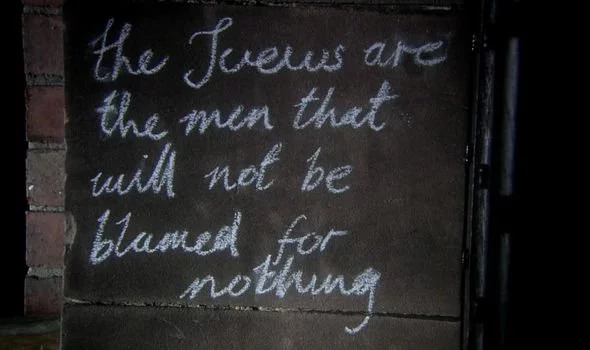
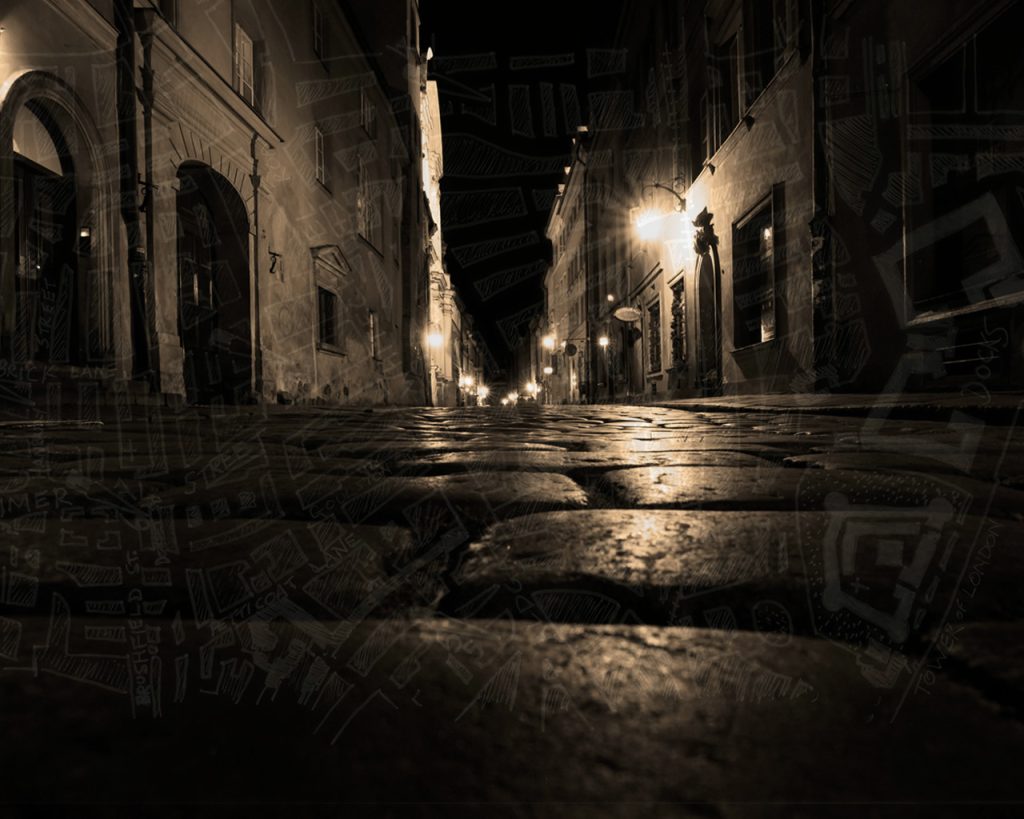
Sadly, I don’t think that the environment I made would be able to convey a complete narrative within its own image. Which is something I very much want my environment to do. To someone not interested in the Jack the Ripper history the environment wouldn’t convey any narrative, instead simply being a Victorian street corner with ripper graffiti to set a time period.
:: What if Operation Sealion was Successful? ::
Project ‘Sealion’ was a Nazi plan in the second world war to invade Britain after the British troops fled from Dunkirk. In essence this ‘what if’ could be further simplified to simply, ‘what if Germany invaded Britain in WW2.?’ This kind of setting has been explored many times in media, from shows such as ‘SS-GB’ (BBC, 2017) to ‘The man in the high castle’ (Amazon Prime, 2019).
This setting would be able to tell a really striking visual story. With historic imagery and an easy to convey scenario through the use of a famous British landmarks being altered. I could also tell a story which is added to the more the viewer knows about the time period in British history, for example I could have banners in the environment talking of the ‘black shirts’ which was a fascist movement in Britain prior to WW2 led by Oswald Mosely. This would allow me to reward the viewer the more knowledge they possess.
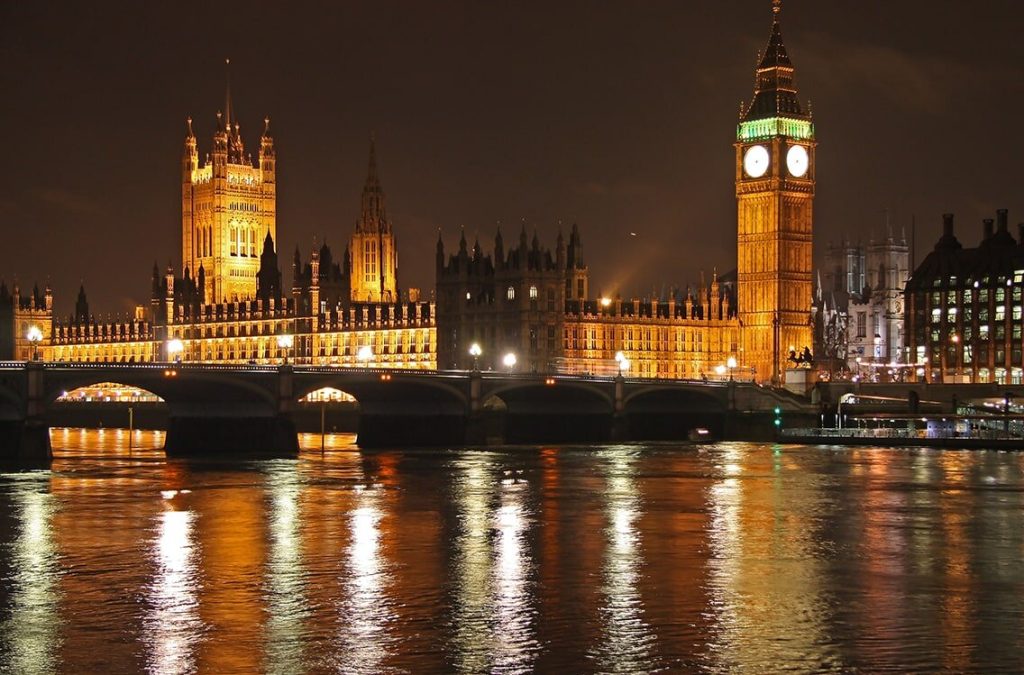

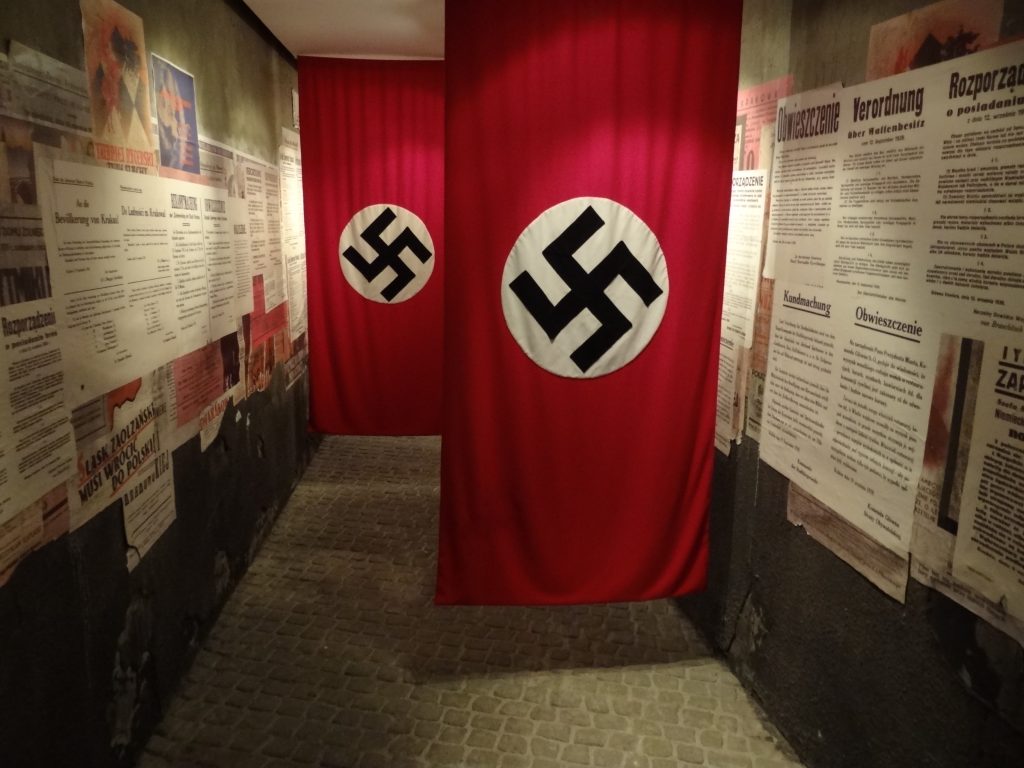
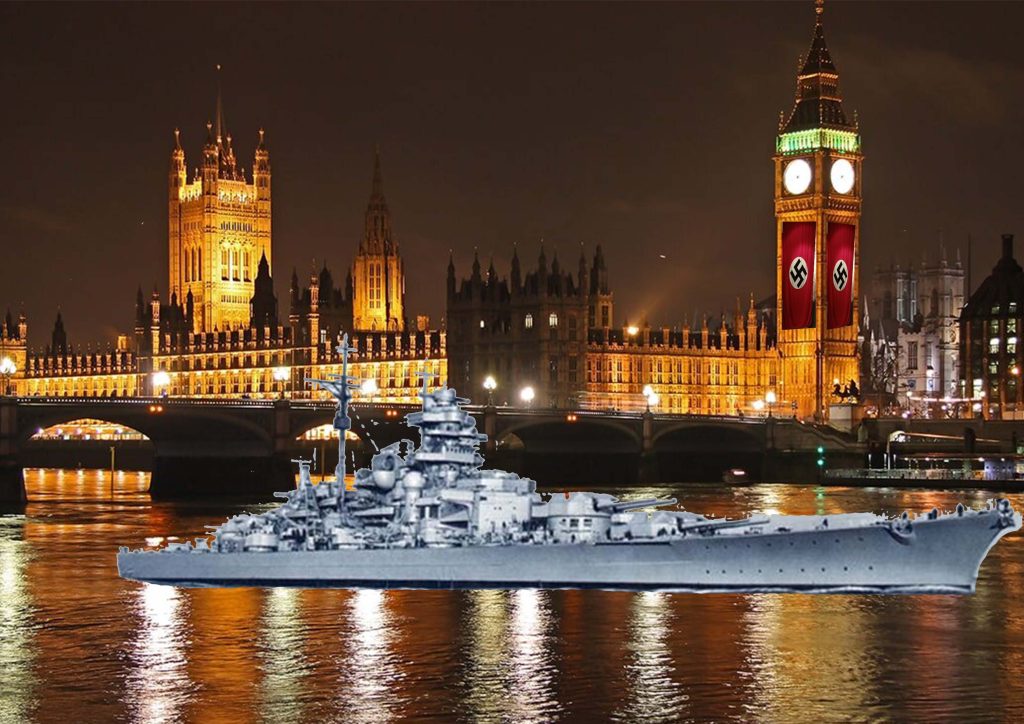
Above you can see a rough imagining of the kind of environment I would create to tell this story (Fig.1), and it is here that I see the negatives of pursuing this story idea. Firstly, in order to tell the story quickly through purely visual means I would need to create a London icon, which would increase the size of the project I am creating massively.
Secondly, it’s a story that would require the use of a few different hero props which would pose a challenge in terms of work load. For example, in the image created above I use the Bismark battleship which was synonymous with the time period in Germany. However, to faithfully recreate this would be a huge ask for me to create given the complexity of the object in the timeframe demanded.
I also think this would be a visual story that would greatly benefit from the use of characters within it. Similar to the ‘Watch Dogs: Legion’ (Ubisoft, 2020) example I gave in my ‘initial response’ blog post. Characters are not something that will be in my environment and so I think this project could well be too ambitious for my timeline and could ultimately fall flat. I worry the imagery created would ultimately just be telling a very shallow alternate history story.
:: What if a Rebellion Took Charge? ::
My third idea is much smaller in scale than the other two, and more solidified in my mind regarding the imagery I would create. Recently while watching the show ‘Narcos’ (Netflix, 2015) and reading books such as ‘Killing Pablo’ (Bowden, M. 2001). I thought about the kind of visual storytelling I could create relating to guerrilla fighting. The challenge with this idea is how to show a guerrilla fighting scenario in a still environment, without the use of characters.


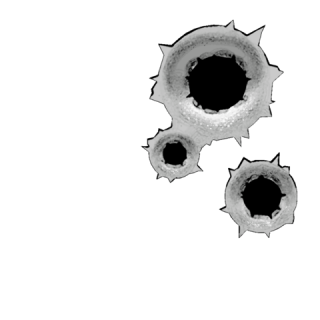
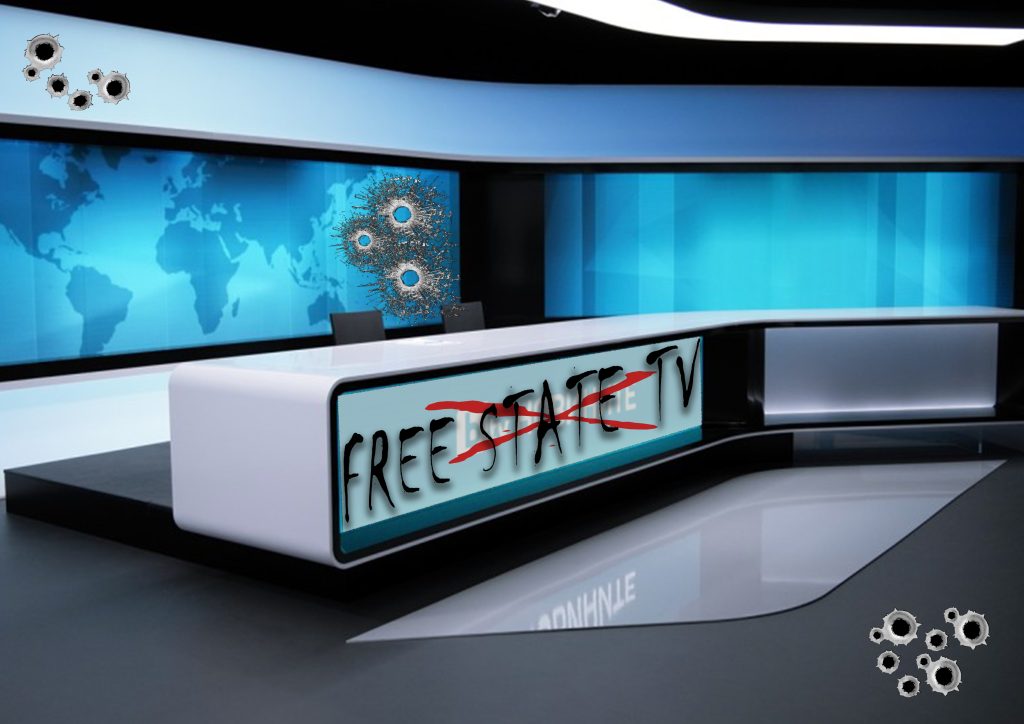
A news station set could be a fun environment, one which has been taken over by guerrilla fighters. I think this scene (Fig.2) could tell a really memorable story, hinting at a larger struggle taking place in whatever country the studio is placed in. I would need to make heavy use of textures with this environment to effectively tell the story being shown.
I would need to ensure the final image is visually engaging enough to keep the viewers’ attention. This could mean recreating an old-fashioned TV studio, with more interesting and less sleek equipment. Also, I will need to make sure the scene is not as empty and bare as modern news sets are.
:: References ::
aestranger (n.d.). ‘What is Environmental Storytelling & why it’s important for you’. [Online Article.] Available online: https://aestranger.com/environmental-storytelling-its-important-for-you/ [Accessed 04/10/2022]
Ahkâm (n.d.). ‘Best Free Bullet Holes Image PNG Transparent Background’. [Online Image]. Available online: https://www.freeiconspng.com/img/22767 [Accessed 08/10/2022]
Asecretstep.co.uk (n.d.). ‘Jack the Ripper – Graffiti at 29 Hanbury Street, where Annie Chapman was found.’ [Online Image]. Available online: http://asecretstep.co.uk/latest-news-blog/photo-6/ [Accessed 98/10/2022]
B. ArtDirection (n.d.) [Pinterest Image]. Available online: https://www.pinterest.co.uk/pin/482518547551843496/ [Accessed 07/10/2022]
Bowden, M. (2001) ‘Killing Pablo: The Hunt for the World’s Greatest Outlaw’. New York City: Atlantic Monthly Press
Jordan (n.d). ‘Developing stories by asking ‘What if…?’: 5 uses’. [Online Article]. Available online: https://www.nownovel.com/blog/developing-stories-asking-what-if/ [Accessed 04/10/2022]
Narcos (2015). Directed by Jose Padilha, Gerardo Naranjo and Michael Stahl-David. Written by Carlo Bernard, Chris Brancato and Doug Miro. [TV Programme]. Netflix. 28th August 2015 (First episode broadcast date)
Rowling, J.K. (1997). ‘Harry Potter: and the Philosophers Stone’. London: Bloomsbury (UK)
Saunders, J (2020). ‘Jack the Ripper unmasked: Note could finally expose serial killer’s identity’ [Online Article; (Imbedded Image referenced)]. Amazon Prime (Image Credit). Available online: https://www.express.co.uk/news/uk/1323900/jack-the-ripper-news-serial-killer-crime-london-real-murderer-note-history-tv-theory-spt (Accessed 08/10/2022)
SS-GB (2017). Directed by Philipp Kadelbach. Written by Neal Purvis and Robert Wade. [TV Programme]. BBC One. 19th February 2017 (First episode broadcast date)
Stickpng.com (n.d.). ‘Download Bullet Hole Glass transparent PNG’. [Online Image]. Available online: http://www.stickpng.com/img/miscellaneous/military/bullet-holes/bullet-hole-glass [Accessed 08/10/2022]
The Man in the High Castle (2019). Directed by David Semel. Written by Philip K. Dick and Frank Spotnitz. [TV Programme]. Amazon Prime. 15th January 2015 (First episode broadcast date)
Wikimedia (n.d.). ‘File:Nazi Swastika Flags and Occupation Posters – Krakow 1939-1945 Museum – In Oskar Schindler’s Factory – Krakow – Poland (9192832647).jpg’. [Online Image]. Available online: https://commons.wikimedia.org/wiki/File:Nazi_Swastika_Flags_and_Occupation_Posters_-_Krakow_1939-1945_Museum_-_In_Oskar_Schindler%27s_Factory_-_Krakow_-_Poland_(9192832647).jpg [Accessed 07/10/2022]
WildLondon.co.uk (n.d.). ‘Houses Of Parliament at night’ [Online Image]. Available online: https://www.wildlondon.co.uk/our-prints/houses-of-parliament-at-night [Accessed 07/10/2022]
Veechxveech.com (n.d.). ‘BTV NEWS STUDIO’ [Online Image]. Available online: https://veechxveech.com/project/broadcast-studios/btv-news-studio/ [Accessed 08/10/2022]